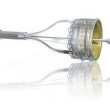Mitral paravalvular leaks are relatively common after surgical mitral replacement, with an incidence of 7%-17%. Most of these are subclinical leaks, a mere echocardiogram finding, but about 3% of patients can develop heart failure, hemolysis, or a combination of both, thus requiring a new intervention. For symptomatic patients, new surgery has been the traditional treatment...
Transcatheter Mitral Valve Replacement Devices Multiply
The Transcatheter mitral valve replacement has been established as gold standard for patients with intermediate or high risk severe aortic stenosis. The supporting evidence was initially gathered with one or two safe and effective devices that worked really well, so that later on prosthetic valves multiplied, for competing companies wanted their share of the market. However,...
These were the 5 most read scientific articles of January
1) The 10 Commandments of ESC’s New STEMI Guidelines The authors have given an entertaining account of the most relevant points and differences between the new STEMI guidelines and the prior ones, from 2014. Read more 2) Burnout Syndrome among Cardiologists For the first time, the American College of Cardiology (ACC) has carried out a survey on this phenomenon,...
The 10 Commandments of ESC’s New STEMI Guidelines
The authors have given an entertaining account of the most relevant points and differences between the new STEMI guidelines and the prior ones, from 2014. The article features 10 points resembling the ten commandments, which makes it easy to read, compared to the tedious task of reading the complete guidelines. 1) The emergency systems should help...
The Importance of Knowing Which Conduits Will a Surgeon Use for Revascularization
Whether a second arterial conduit improves outcomes in patients undergoing myocardial revascularization surgery is and will remain unclear until the 10-year results of the ART (Arterial Revascularization Trial) are published. Consequently, arterial conduits other than the left internal thoracic artery are seldom used in daily practice. Using a database including 126 non-federal hospitals in California, researchers...
Incidence of Cancer in Adult patients with Congenital Heart Disease
Adults with congenital heart disease are exposed to cumulative radiation doses, from multiple catheterization procedures. Seeing as these patients are exposed since early age, the chance of stochastic effect due to radiation exposure are relatively higher than that of the elderly population. It is clear the chance of incident cancer in adults with congenital heart disease is higher...
Lotus Valve in Real Life Patients: the near total lack of leaks is its greatest strength
Even though the incidence of complications in transcatheter aortic valve replacement (TAVR) have significantly decreased, there is one in particular that remains a concern since, when mild, it is associated to increased events rate. This complication is prosthetic paravalvular leak , which happens between the native annulus and the stent. The Lotus valve, completely repositionable, uses a...
Does a Combination of Diabetes and Acute Coronary Syndrome Change the Revascularization Strategy?
The results of the FREEDOM (Future Revascularization Evaluation in Patients With Diabetes Mellitus: Optimal Management of Multi-vessel Disease) trial have shown a lower rate of events in patients with diabetes and stable multivessel disease who were randomized to undergo myocardial revascularization surgery, compared to those who underwent angioplasty. Surgery even showed a mortality reduction that...
The Use of Intravascular Imaging to Guide PCI Reduces Cardiovascular Death Risk, Compared to Angiography
Intravascular imaging, which includes ultrasound intravascular (IVUS) and optical coherence tomography (OCT), shows live details that better characterize post stenting plaque, anatomy and outcomes. The already familiar limitations of the angiography has lead us to think that IVUS and OCT could improve clinical outcomes; however, we should still find the evidence to support this claim. To shed some...
Quality of Life Between Surgery and Angioplasty for the Treatment of Left Main Disease
In recent years, angioplasty with drug-eluting stents (DES) has emerged as an alternative to myocardial revascularization surgery in patients with left main coronary artery disease. Both European and American guidelines offer a Class IIa recommendation for left main coronary artery (LMCA) angioplasty in selected patients. The EXCEL (Evaluation of Xience Versus Coronary Artery Bypass Surgery for...









